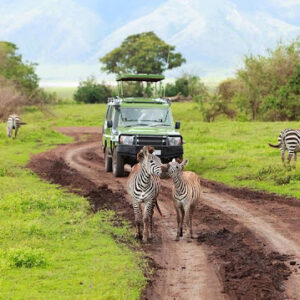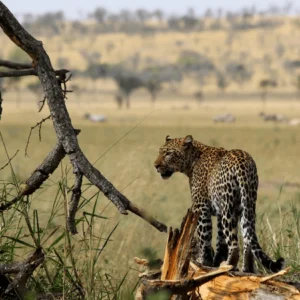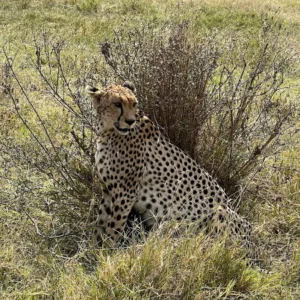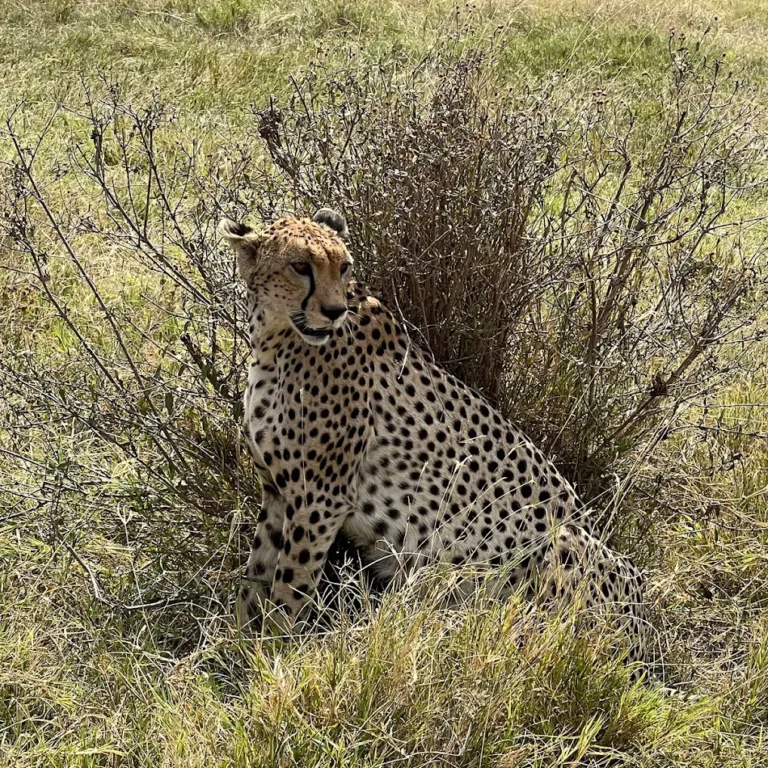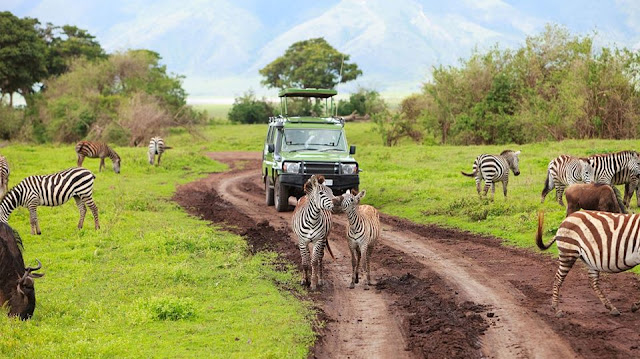Everything You Need to Know About Tarangire National Park.
Tarangire National Park, nestled in the heart of Tanzania, is a hidden gem that promises an unparalleled safari experience. Spanning over 2,850 square kilometers, this national park is renowned for its diverse landscapes, teeming wildlife, and a unique ecosystem that attracts nature enthusiasts worldwide. Tarangire is often overshadowed by its more famous neighbors, such as the Serengeti and Ngorongoro Crater. However, it has its distinct charm, characterized by the vast savannahs, lush greenery, and the meandering Tarangire River that serves as a lifeline for the park’s inhabitants. Tarangire National Park is a captivating destination that promises an unforgettable experience for all who visit. Whether you’re a seasoned safari-goer or a first-time traveler, this park offers a perfect blend of wildlife, scenery, and adventure. So pack your bags and get ready for an experience of a lifetime!
Overview – Tarangire National Park
Discover Tarangire National Park – the Tarangire National Park known as a wonderful birding destination and also features large numbers of game, particularly during the dry season, when the Tarangire River is the only source of water in the area. The landscape is of particular interest too, due to the high number of scenic baobab trees.
It the 6th largest National Park in Tanzania and offers some unrivalled elephant sightings – indeed, it is estimated that the Park is home to the largest elephant population in northern Tanzania – approximately 2,500 – and these numbers are rapidly increasing by an estimated 6% per year.
Safari Reviews – Tarangire National Park
Visitors to Tarangire consistently rave about the intimate and authentic safari experiences it offers. Unlike some of the more crowded parks, Tarangire allows for a more exclusive encounter with wildlife. The park is particularly famous for its large elephant population, and witnessing these majestic creatures in their natural habitat is a highlight for many.
Safari-goers often appreciate the knowledgeable guides who navigate the terrain, sharing insights into the park’s ecosystem, animal behavior, and conservation efforts. The park’s policy of limiting the number of vehicles in certain areas ensures a more serene and undisturbed safari experience, allowing visitors to connect with nature on a deeper level.
Wildlife & Animals – Tarangire National Park
Tarangire a haven for wildlife enthusiasts, boasting a rich biodiversity that includes a variety of mammals, reptiles, and insects. Spot large herds of elephants, often seen congregating near the Tarangire River. Lions, leopards, and cheetahs are among the predators that roam the savannah, while ungulates like wildebeest, zebras, and impalas add to the vibrant tapestry of the park.
Birdwatchers will be delighted by the diverse avian population, with over 500 bird species recorded in the park. From the vibrant lilac-breasted roller to the majestic Martial eagle, Tarangire is a birding paradise that offers endless opportunities for bird enthusiasts.
Birds – Tarangire National Park
Bird enthusiasts will find Tarangire a paradise, as it boasts over 500 species of birds. From the majestic secretary bird and the vibrant lilac-breasted roller to the striking ostrich, the avian population is both diverse and colorful. The park is particularly rich in birdlife during the wet season, when migratory species flock to the area, creating exceptional birdwatching opportunities. The park’s diverse habitats, including riverine forests, acacia woodlands, and open grasslands, provide a perfect environment for a wide range of bird species.
Birdwatchers can spot colorful species like the yellow-collared lovebird, superb starling, and the iconic Maasai giraffe. Raptors, including vultures and eagles, soar through the skies, adding to the dynamic spectacle that is Tarangire’s birdlife.
Best Time To Visit Tarangire National Park
Choosing the right time to visit Tarangire crucial for maximizing your safari experience. The dry season, from June to October, is considered the best time to visit. During this period, wildlife congregates around the Tarangire River, providing excellent game viewing opportunities. The vegetation is also sparse, making it easier to spot animals.
However, the wet season, from November to May, has its allure. The landscape transforms into a lush, green paradise, and the birdlife is particularly abundant. The presence of migratory birds adds to the overall diversity, making it a unique time for nature enthusiasts.
Dry Season (June to October): This is the optimal time for wildlife viewing, as animals congregate around the Tarangire River. The vegetation is sparse, making wildlife easier to spot. However, it is also the peak tourist season, so expect more visitors.
Wet Season (November to May): While wildlife is more dispersed, the lush landscapes are ideal for photography, and birdwatching is at its peak. The park is less crowded, offering a more tranquil experience.
Weather & Climate – Tarangire National Park
The climate in Tarangire typically tropical, with distinct wet and dry seasons. Daytime temperatures can reach up to 30°C (86°F) during the dry months from June to October, while nights can cool down quite a bit. The wet season brings rain from November to May, with the heaviest precipitation occurring from March to May. Visitors should prepare accordingly and check forecasts before traveling.
Travelers should pack accordingly, with lightweight clothing for the daytime and warmer layers for the cooler evenings. It’s advisable to bring rain gear if visiting during the wet season.
Tarangire experiences a temperate climate with distinct wet and dry seasons. Dry Season (June to October): Sunny with little rainfall. Daytime temperatures average around 24°C (75°F), cooling to 14°C (57°F) at night. Wet Season (November to May): Afternoon temperatures around 28°C (82°F), with nighttime temperatures around 17°C (63°F). Rainfall is more frequent, especially from March to May.
Getting There – Tarangire National Park
Accessing Tarangire National Park is relatively straightforward. The nearest airport is Kilimanjaro International Airport (JRO), located about 120 kilometers away. From there, travelers can opt for a pre-arranged shuttle service or hire a car. Alternatively, it’s possible to join a guided safari tour that includes transportation and accommodation. Visitors can opt for a domestic flight to the Kuro Airstrip, located near the park, followed by a short drive to the entrance. Alternatively, road transfers from Arusha are available for those who prefer a scenic drive.
Malaria & Safety – Tarangire National Park
Travelers should note that Tarangire is in a malaria-risk area; therefore, taking preventive measures, such as anti-malarial medications and using insect repellent, is highly recommended. Additionally, staying in reputable lodges and following the guidance of local park authorities enhances safety during your visit.
As with many destinations in sub-Saharan Africa, malaria is a concern in Tarangire National Park. Travelers are advised to take anti-malarial medication, use insect repellent, and wear long sleeves and pants, especially during the evenings when mosquitoes are most active. Safety is generally not a significant concern in the park, but it’s essential to follow the guidelines provided by park authorities and guides.
Accommodations – Tarangire National Park
Tarangire offers Various accommodation options that cater to different budgets within and around Tarangire National Park. From luxurious lodges offering incredible views and amenities to more affordable campsites where one can enjoy the sounds of nature, there is something for everyone. Staying inside the park allows for convenient access during early morning game drives.
Luxury Lodges and Camps: These provide upscale amenities and personalized services for a comfortable stay. Mid-Range Lodges: Offering a balance between comfort and cost, these lodges provide quality services and facilities. Budget Campsites: For those seeking a more rustic experience, the park has designated campsites that allow visitors to immerse themselves in nature.
Some popular choices include the Tarangire Treetops, a luxury treehouse-style lodge, and the Swala Camp, known for its intimate setting and excellent game viewing opportunities. It’s advisable to book accommodations well in advance, especially during peak safari seasons.
Tours and Safaris – Tarangire National Park
Embarking on a guided safari is one of the best ways to explore Tarangire. Many tour operators offer a range of experiences, including half-day trips, full-day safaris, and multi-day excursions that combine visits to other national parks. Expert guides enhance the experience, providing valuable insights into the park’s ecosystems and wildlife.
Game Drives: The most popular safari activity, offering opportunities to witness diverse wildlife in their natural habitats.
Walking Safaris: Experience the wild up close with guided walking safaris, led by professional rangers who provide insights into the smaller details of the ecosystem.
Night Safaris: A rare opportunity to see nocturnal creatures like civets, genets, and lions on the hunt under the cover of darkness.
Hot Air Balloon Safaris: For a truly magical experience, soar over the park at dawn in a hot air balloon, witnessing wildlife from above and enjoying a champagne breakfast in the bush.
Tarangire National Park Travel Guide
When planning a trip to Tarangire, consider factors such as travel time, types of tours, and personal interests. Researching tour operators and accommodations in advance can lead to better travel experiences and ensure you don’t miss out on must-see attractions, one of the top tips ultimate guide to Tarangire National Park.
Tarangire National Park Map
Consulting a detailed map of Tarangire National Park crucial for navigating the park’s vast terrains. Maps can be obtained from visitor centers and tour operators, providing vital information about points of interest, accommodations, and road conditions within the park.
Things to Do in Tarangire National Park
Apart from wildlife viewing, there are a host of activities to enjoy in Tarangire. These include guided walking safaris for a more intimate encounter with nature, cultural visits to nearby Maasai villages, and birdwatching excursions. The stunning landscapes offer breathtaking photographic opportunities at every turn, ensuring that Tarangire leaves an indelible mark on every visitor’s heart.
Tarangire National Park Photos
Tarangire National Park offers a visual feast for wildlife enthusiasts and photographers alike. The park’s landscapes are dominated by iconic baobab trees, vast savannahs, and the meandering Tarangire River. Photographs often capture the grandeur of these ancient trees, with their massive trunks and twisted branches reaching towards the sky. Wildlife is abundant, with images showcasing large herds of elephants, graceful giraffes, and a variety of antelope species. Birdwatchers will also appreciate the vibrant plumage of over 550 bird species, including the striking yellow-collared lovebird and the marabou stork. The park’s diverse ecosystems provide a rich tapestry of colors and textures, making it a photographer’s paradise..
Unique Landscapes and Attractions
Baobab Trees: The park dotted with ancient baobab trees, some over a thousand years old, creating a surreal and iconic landscape. Tarangire River: The lifeline of the park, the river draws animals from miles around during the dry season, offering exceptional wildlife viewing.
Kitibong Hill: This elevated area provides panoramic views of the park and is a great spot for photography. Poacher’s Hide: An ancient baobab tree with a hollow interior, once used by poachers as a hideout, now serves as a historical point of interest.
Tarangire National Park Packing List
When visiting Tarangire, pack light but smart. Essentials include neutral-colored clothing, a wide-brim hat, sunscreen, sunglasses, and insect repellent. Bring a good pair of walking shoes, binoculars for wildlife and birdwatching, and a camera with extra batteries. A light jacket is useful for cool mornings and evenings. Don’t forget your travel documents, personal medications, and reusable water bottle. If visiting in the rainy season, a lightweight raincoat is also recommended.
Wildlife Comparison: Ngorongoro Crater vs Tarangire vs Serengeti National Park
Ngorongoro offers a dense concentration of wildlife in a volcanic crater, ideal for spotting the Big Five in a compact area. Tarangire is famous for its massive elephant herds and rare species like the fringe-eared oryx. Serengeti, the largest of the three, is renowned for the Great Migration and its vast open plains teeming with predators and grazers. Each park provides a unique safari experience, making them perfect complements on a Northern Circuit tour.
Tarangire National Park FAQs
Tarangire National Park, located in northern Tanzania, is one of the country’s most stunning natural wonders, known for its diverse wildlife and unique landscapes. As visitors plan their adventures to this remarkable destination, it’s common to have questions. Here are some frequently asked questions (FAQs) that aim to provide clarity and enhance your experience while visiting Tarangire National Park.
What is the best time to visit Tarangire National Park? The ideal time to visit Tarangire National Park is during the dry season, which runs from June to October. During this period, animals congregate around the limited water sources, making it easier for visitors to spot wildlife. However, the park is also beautiful during the wet season, from November to May, as the landscapes transform with lush greenery and blooming flowers, attracting different bird species.
What wildlife can I expect to see in Tarangire National Park? Tarangire is renowned for its large herds of elephants, often seen roaming alongside giraffes, zebras, and wildebeests. Additionally, the park is home to a variety of other wildlife, including lions, leopards, cheetahs, buffalo, and numerous antelope species. Birdwatchers will be delighted to find over 500 bird species, including the striking African Tree Sparrow and the colorful Lilac-breasted Roller.
Are there guided tours and safaris available in Tarangire National Park? Yes, Tarangire National Park offers a range of guided tours and safari options. Visitors can choose from half-day, full-day, or overnight safaris, often led by experienced guides who provide insight into the park’s ecology and wildlife. It’s recommended to book through reputable tour operators to ensure a safe and informative experience.
Is accommodation available inside the Tarangire National Park? Tarangire offers various accommodation options suitable for different budgets, from luxury lodges and tented camps to more basic camping facilities. Staying within the park allows you to immerse yourself in the natural surroundings and maximize your wildlife viewing opportunities, particularly during early morning or evening hours.
Are there any park regulations I should be aware of about visiting Tarangire National Park? Absolutely! Visitors should always stay with guided groups and follow the instructions of their guides. It’s essential to respect wildlife and keep a safe distance, refrain from feeding animals, and adhere to park speed limits to minimize disturbance to both animals and their habitats. Additionally, park rules are in place to ensure safety and preserve the natural environment.
What should I pack for a visit to Tarangire National Park? When visiting Tarangire, it’s crucial to pack essential items, including a good pair of binoculars for wildlife watching, a camera for capturing stunning landscapes and animals, sunscreen, a wide-brimmed hat, and comfortable hiking shoes. Don’t forget insect repellent for those pesky mosquitoes! It’s also wise to bring layered clothing, as temperatures can vary throughout the day.
How can I access Tarangire National Park? Tarangire is accessible by road from Arusha, which is approximately a two-hour drive away. Additionally, visitors can reach the park via chartered flights to nearby airstrips. It’s advisable to plan transportation, especially during peak tourist season.
Is it worth visiting Tarangire National Park? Absolutely—Tarangire National Park is a must-visit for any safari enthusiast. Often overshadowed by its more famous neighbors like the Serengeti, Tarangire offers a quieter, more intimate wildlife experience. It’s especially renowned for its massive elephant herds, which gather around the Tarangire River during the dry season, offering incredible viewing opportunities.
What is unique about Tarangire National Park? What truly sets Tarangire apart is its striking landscape, dotted with ancient baobab trees and lush swamps that attract an astonishing variety of wildlife and over 550 bird species. The park also boasts rarer animals like the fringe-eared oryx and long-necked gerenuk, not commonly seen elsewhere in Tanzania. With fewer tourists and a rich diversity of flora and fauna, Tarangire provides a more relaxed and authentic safari atmosphere, perfect for those seeking both adventure and serenity. Whether you’re a first-time visitor or a seasoned explorer, Tarangire delivers a unique and rewarding experience.
Which is better Lake Manyara or Tarangire? Tarangire vs. Lake Manyara National Park. The choice between Lake Manyara and Tarangire National Park in Tanzania depends on your safari priorities. Tarangire is known for its abundant elephants and diverse large mammal populations. Lake Manyara, on the other hand, is famous for its unique tree-climbing lions and diverse birdlife, especially around its soda lake. If you prioritize seeing large numbers of elephants, Tarangire is the better choice. If you are more interested in birdwatching and the unique behavior of tree-climbing lions, Lake Manyara is more appealing.
Final thought: Tarangire National Park
Tarangire National Park stands as a testament to Tanzania’s commitment to preserving its natural treasures. Whether you seek the thrill of spotting the Big Five, or the enchantment of diverse birdlife. Or the serenity of the African wilderness, Tarangire delivers an unforgettable safari experience. Plan your visit wisely, respect the wildlife and the environment, and let Tarangire cast its spell on you.

